
Let Have a Coze
December 2011
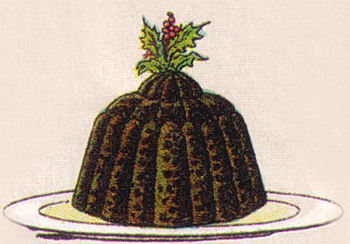
I’ve gone through the year writing about the major events –mainly battles for 1811. But it is December now and time to party. So how did the British entertain themselves in the Peninsula? The Marquess of Londonerry, a veteran of the war, wrote in The Story of the Peninsular War -- No set of persons could more industriously strive to unite mirth with hardships, and relaxation with severe duty . . . In our quarters we lived gaily and well. A spirit of good-fellowship and hospitality everywhere prevailed; and in the midst of war, balls, private theatricals, and agreeable parties were things of continue occurrence.
According to Antony Brett-James in Life in Wellington’s Army, in which I found much of the following information, the pastimes enjoyed by the men and officers were varied. They ranged from the common to the sublime (at least in the eyes of some of those enjoying them). Something that was always available was conversation. In these days of texting and tweeting it may be difficult how much these men enjoyed conversing about any and all topics: from the constant arears in pay, the weather, what the French were up to, comparing notes on events to political machinations at home and in the Peninsula. Especially enjoyed was conversation when a soldier came across a friend or acquaintance from home or even someone with whom they shared an acquaintance as these were a rare source of home-local information and a chance to enjoy reminiscing on shared experiences.
Another enjoyment was the Spanish habit of smoking which many in the army took up. It became particularly enjoyable during the hardships of the campaign. In place of smoking some officers took snuff. The difficulty with snuff, however, was that there was none in Spain except that sent from England.
Next came reading be it newspapers or books. Both were a valuable commodity as they were in short supply. Anyone who received one from home was very popular. The Morning Post, the Day, the London Chronicle and the (London) Times were all popular. Some even joked (or perhaps not) that the newspapers from England were the only way to know what Parliament meant to do. Books were acquired from the Spanish as well as from the discarded baggage of the retreating French. Many of the officers could read, French, Latin, and Greek and got books from the churches and cathedrals in Spain. Any book was valued and passed from hand to hand.
Card parties were popular. Some men gambled but most preferred whist. Balls and theatricals where the officers assumed both male and female roles as well as built backdrops and stage props also relieved boredom. Another form of party was the tertulia which meant assembly or reception. They included invitations to both ladies and men’s groups. At the women’s version were at the homes of wealthy women and would include conversation and music. At the men’s they gentlemen would sit around and discuss the news of the day smoking cigars and drinking hot chocolate.
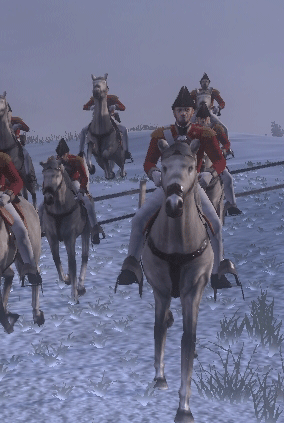
Sports were another avenue of entertainment. From cricket to fox hunting. Many officers kept hounds just for hunting. Wellington himself hunted twice a week and kept a pack of sixteen pair hunted by Captain Wood. Some say this activity taught the officers the lay of the land and proved invaluable for that.
Dinner parties were also popular, especially at Christmas. Sometimes the dinners were simple and at other times elaborate like when Wellington had thirty-six officers to dine. An effort was made to obtain special foods and delicacies. Some of these were sent by relatives in England, some were purchased, and some were “borrowed.” One Christmas a German officer in the King’s German legion had punch, plum-pudding, roast beef, and a Christmas tree made from a lemon tree decorated with lights and oranges.
No matter how you celebrate Christmas may it be merry and bright! Happy Christmas! JV
November 2011
Life in Bivouac and Cantonments
Bivouac--military cam, -a very simple temporary camp that is set up and used by soldiers or mountaineers Cantonments--temporary accommodations for troops, especially the winter quarters of an army
At the end of October in 1811 active campaigning for the year ended. Both the French and the Allied (British and Portuguese) Armies went from bivouac into cantonments. First lets talk about life in bivouac. It sounds a bit like life in an unknown country; for most of the men in the British army it was just that. The weather, too dry or too wet, the insects, animals, and the habits of the people of Portugal and Spain were often exasperating. The British officers especially found camp life a drastic change to their usual circumstances. 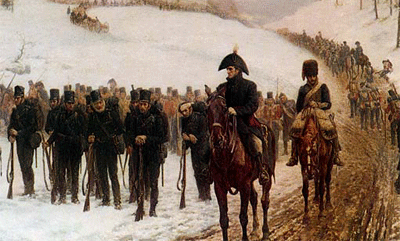
Captain Sir John Kincaid in his memoir Adventures in the Rifle Brigade writes this about life in bivouac: “As it is possible that some of my readers might never have had the misfortune to experience the comforts of a bivouac and as the one which I am now in contains but a small quantity of sleep, I shall devote a waking hour for their edification.
“When a regiment arrives at its ground for the night, it is formed in columns of companies, at full, half, or quarter distance, according to the space which circumstances will permit it to occupy. The officer commanding each company then receives his orders; and after communicating whatever may be necessary to the men. He desires them to ‘pile arms and make themselves comfortable for the night.’ Now I pray thee most sanguine reader, suffer not they fervid imagination to transport thee into elysian fields at the pleasing exhortation conveyed in the concluding part of the captain’s address, but rest thee contentedly in the one where it is made, which in all probability is a ploughed one . . . and under the melting influence of a shower of rain.” Kincaid goes on to explain how the soldiers of a company have the right to the ground next to their arms and their officers a wider area limited to the distance a bugle can be heard. He says there are several levels of comfort but that usually only two exist:“The first, and worst, is to arrive at the end of a cold wet day, too dark to see yoyur ground, and too near the enemy to be permitted to unpack the knapsacks or to take off accoutrements; where, unicumbered with baggage or eatables of any kind, you have the consolation of knowing that things are now at their worst and that any change must be one for the better. You jkeep yourself alive for awhile in collecting material to feed your fire. You take a smell at your empty calibash which recalls to the your remembrance the delicious flavor of its last drop of wine. You curse your servant for not having contgrived to send you something or other from the baggage even though you know that it was impossible. You damn the enemy for being so near you, through probably, as in the present instance, it was you that came so near them. And Finally you take a whiff at the end of a cigar, if you have one, and keep grumbling through the smoke, like distant thunder through a clou8d, until you tumble into a most warlike sleep.
The next and most common one, is, when you are not required to look quite so sharp, and when the light baggage and provisions coming in at the heel of the regiment. If it is early in the day, the first thing to be done is to make some tea, the most sovereign restorative for jaded spirits. We then proceed to our various duties. The officers of each company form a mess (dining group) of themselves. One remains in the camp to atte4nd to the duties of the regiment; a second attends the mess; he goes to the regimental butcher and bespeaks a portion of the only purchasable commodities, hearts, livers, and kidneys and also to see whether he cannot do the commissary out of a few extra biscuit or a canteen of brandy; and the remainder are gentleman at large for the day. But while they go hunting among neighbouring houses for curiosity they have always an eye to their mess and omit no opportunity of adding to the general stock.Dinner hour, for fear of accidents, is always the hour when dinner can be got ready and the 14th section of the articles of War is always most rigidly attended to by every good officer parading himself round the camp-kettle at the time fixed, with his knapsack in his hand. . . . A well regulated knapsack ought never be without the following furniture, unless the perishable part is consumed, viz. a couple of biscuits, a sausage, a little tea and sugar, a knife, fork, and spook, a tin cup (which answers to the names of tea-cup, soup-plate, wine-glass, and tumbler) a [air of socks, a piece of soap, a tooth-brush, towel, and comb, and half a dozen cigars.
After doing justice to the dinner, if we feel in a humour for additional society we transfer ourselves to some neighboouring mess taking our cups and whatever we mean to drink along with us, for in those times there is nothing to be expected from our friends beyond the pleasure of their conversation and finally we retire to rest. To avoid inconvenience by the tossing off of the bedclothes each officer has a blanket sewed up at the sides like a sack into which he scrambles and with a green sod or a smooth stone for a pillow composes himself to sleep . . . . He tumbles into sleep . . . No matter that the veteran’s countenance is alternately stormed with torrents of rain, heavy dews, and hoar –frosts, no matter that his ears are assailed by a million mouths of chattering locusts and by some villainous donkey who every half-hour pitches a bray note which is instantly taken up by every mule and donkey in the army and sent echoing from regiment to regiment over hill and valley until it dies in the distance so matter the scorpion is luring beneath his pillow , the snake winding his slimy way by his side and the lizard galloping over his face, wiping his eyes with its long, cold tail. All is unheeded until the call to arms. The first note of the melodious bugle places the soldier on his likes like lightning.
In Life in Wellington’s Army by Antony Brett-Jones there is a chapter on bivouacs that neatly sum up the life by quoting Charles Napier writing to his mother in 1811: “I make no apologies for the dirt of this note; for flead, bugged, centipeded, beetled, lizarded, and earwigged, cleanliness is known to me only by name. Moreover a furze-bush makes a bad table for writing on and a worse chair when breeches are nearly worn out with glory.”
Brett-Jones also Quotes Ensign George Bell of the 34th Foot who spent his first month in Portugal in a rainy October. The ensign had a cloak and a blanket for his bed, never undress, was never completely dry, and had to live “like any other wild beasts and always up and armed ready for anything one hour before daylight and never dismissed until we could see a white horse a mile s=distant.” When asked as a new officer how he slept after a very wet night he answered, “Slept like a fish. UI believe they sleep best in water!” “Bravo! You’ll do,” came the reply and he was accepted by all in the regiment.
Soldiers could be bivouacked in vineyards, in turnip fields, under cork trees, beside a river with chestnut trees, pasture, or ploughed ground. Just about anywhere and almost always wet. Just thinking about their uncomfortable, to say the least, circumstances reminds me that I have much to be thankful for. Happy Thanksgiving 2011! JV
October 2011
OCTOBER 1811
At the end of September we left off with the French in full retreat. All of their cantonments before the actions from September 24-29th were broken up. On September 29th Wellington gave the order for his forces to begin to retire. Graham with the 1st and 6th Divisions went to winter quarters around Guarda, Celorico and Freixadas. The 7th Division took up winter quarters around Penamarcor to the south. The 3rd, 4th, and Light Divisions marched back to the Spanish frontier to set up a watch on Cuidad Rodrigo (Rodrigo). The light cavalry brigades under Anson, Alten, and Slade rotated the duty of covering the front of the Light and 4th Divisions strung out along the Augeda. Some of their troops were positioned twenty miles to the rear where the heavy dragoons and the cavalry’s headquarters were placed near Alverca.
Soon after the divisions took up their respective posts Wellington sent cavalry pickets (A small detachment of troops sent beyond the front to watch and warn of an enemy's approach) across the Augeda River to block the road from Rodrigo to Salamanca. They were commanded not to rest any serious altercation with the French but just to keep an eye and report the French force’s movements. More effective at actually blockading were the Spanish guerillas under Julian Sanchez who freely roamed the area.
When the French had come to revictualize Rodrigo they had brought six months of supplies. However the entire force remained in the area to face the British this was reduced to only two months worth. It was clear from the manner of the French retreat that they would have to marshal another great force in the near future to restock Rodrigo.
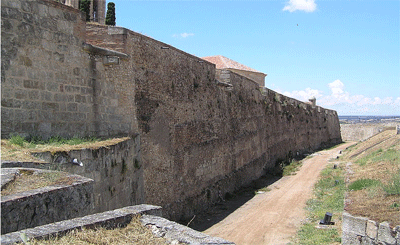 As the opposing forces postured Wellington became better prepared for an attack on Rodrigo. Pictured to the left is one of Cuidad Rodrigo's outer walls. First of all his huge siege train was almost completely formed at Villa de Ponte. Also the repairs on the fortress at Almeida were almost finished. As soon as that work was finished Wellington planned to move the siege train there, just two days from Rodrigo. This didn’t take place until late November.
As the opposing forces postured Wellington became better prepared for an attack on Rodrigo. Pictured to the left is one of Cuidad Rodrigo's outer walls. First of all his huge siege train was almost completely formed at Villa de Ponte. Also the repairs on the fortress at Almeida were almost finished. As soon as that work was finished Wellington planned to move the siege train there, just two days from Rodrigo. This didn’t take place until late November.
The most important fact in a decision to strike a serious blow against Rodrigo was the placement of the opposing French forces. The Army of Portugal had returned to its camps across the Sierra de Gata. Foys’ army, depleted by the stresses of marching across mountains during the winter were sent to recuperate at a safe distance. The 2nd Division occupied Ovila. The rest were place near Almarez, Talavera, Bejar, and Oropeso with the heavy cavalry also at Talavera and the light cavalry along the Alagon River. Dorsenne’s Army of the North was widely dispersed and was no longer a threat to Portugal. Napoleon ordered the retaking of the Asturias and thus even more French troops were drawn away from the area around Rodrigo and redirected to aid Suchet. The 2nd Division, left on front line.
Even with the movement of the French troops a deadlock existed between the opposing forces. Wellington watched for French movement and the French waited for the British general to take action. As long as neither moved the stalemate continued. This lasted until late December. JV
September 2011
September 1811At the end of August 1811 Wellington had blockaded Cuidad Rodrigo (Rodrigo) and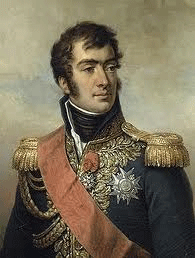 awaited the reaction. On September 3rd he learned Dorsenne was making forced marches from Astorga toward Salamanca where relief supplies were being gathered. The French Marshal Marmont (picture to the right) learned in mid-September that a siege train was headed towards Rodrigo and decided with these two joining forces he needed to act. On September 17th an intercepted French letter informed Wellington that Foy was leaving Truxillo and that Montbrun’s cavalry were crossing the sierra with infantry columns in the rear.
awaited the reaction. On September 3rd he learned Dorsenne was making forced marches from Astorga toward Salamanca where relief supplies were being gathered. The French Marshal Marmont (picture to the right) learned in mid-September that a siege train was headed towards Rodrigo and decided with these two joining forces he needed to act. On September 17th an intercepted French letter informed Wellington that Foy was leaving Truxillo and that Montbrun’s cavalry were crossing the sierra with infantry columns in the rear.
Wellington had decided to fight if Dorsenne and Marmont were not part of the mix. But further intercepted dispatches revealed the entire Armies of Portugal and the North were combining. That meant the British would face 55 to 65,000 French. Wellington had 46,000 actually fit to fight. The Allied (British and Portuguese) cavalry were vastly outnumber—2900 to almost 5000 French Wellington would have had more troops but for two things. Some of his men were still suffering from the Guadiana fever and his most recent replacements were sent from the failed Walchren Campaign and almost half were in hospital suffering from the fever that had killed more of them than the campaign. In all over 14,000 troops were in hospital.
Wellington refused to face the French beyond the Agueda River but he also did not want to give up any more ground than was necessary. He therefore told Picton and Craufurd, the commanders of his two blockading divisions to pull back and open the Salamanca road but not to give up the ground around Rodrigo unless attacked in force.
By September 22nd the two French armies had joined forces. Between them they had 58,000 men. The land before Rodrigo was flat and open –a very poor choice to stand and fight. Wellington knew he was in for a difficult time but made it worse by not taking his customary cautious approach. Believing the French would only restock Rodrigo he left Craufurd and Picton in advanced positions throughout the 23rd and 24th. Also Graham was not called in from the left. Wellington also did not call the 7th Division up from headquarters.
On September 23rd the French appeared in much larger numbers than expected. But when they made no move to attack Wellington concluded he was safe and left his forces scattered throughout the area instead combining them. For instance the allied infantry were spread out over a line of six miles. Wellington also seems to have ignored the fact that he was only fifteen miles from a French force of 20,000. When Marmont realized the British were so scattered and thus open to defeat he had Dorsenne send out two groups of cavalry. The one had no consequences but Montbrun’s reconnaiscence brought on heavy action when the French broke through the British cavalry screen. The British were only saved from a severe mauling because Marmont thought Wellington had hidden his reserves from view as he usually did and especially by the heroic actions of the 1st Hussars of the Kings German Legion.
Wellington scrambled to call the various divisions together on the 26th. Marmont fortunately decided not call his infantry up from the rear and engage in battle. He merely sent Montbrun to try and break through the British and see where all their troops were. This saved Wellington’s forces. By heroic efforts Montbrun was thrown back. The combat of El Bodon was a long straggling affair with the British able to stave off the French on all sides. The Allies lost around 149 men while the French casualities were around 200. A fortunate escape for Wellington helped by the many errors made by the French commanders. Further action on the 27th resulted in more causalities on both sides but by the 28th Wellington was able to retreat and take up a position where he could wage a successful battle behind the Agueda but the French refused to meet him. By the 28th the French were retreating. JV
August 2011
Continuing from last month’s Coze we find Wellington pondering which move to make next: August 1811Having drawn his army back in July Wellington began to consider his next possible course of action. He had many things to take into consideration. To reprise them briefly in terms of French army movement:
1. In July Marshal Marmont moved his “Army of Portugal” to a central position so he could either move to help the 5th Corps near Badajoz in Estramadura or Dorseene’s Army of the North in Leon. To be set to aid Cuidad Rodrigo or Salamanca he placed a brigade of cavalry at Truxillo. His major problems were lack of promised replacement troops, a food supply, and wagons to move anything all of which Wellington was aware.
2. Marshal Soult in Andalusia had his hands full trying to control the area with too few troops. He was counted a negligible factor by Wellington.
Wellington also knew that Marmont could move quickly to help Soult. That made him rule out any offensive in Andalusia because the Anglo Portuguese army could be cut off. Now was a new siege on Badajoz tempting for the same reason. This ruled out taking any action south of the Tagus and there remained only the possibility of making another move on Cuidad Rodrigo. Wellington gave three reasons to the War office for taking such an action.
1. He would have the aid of the militia of northern Portugal
2. The layout of the area of operations was in his favor with protection of the mountains at his back instead of an open plain.
3. To draw Marmont away from Soult separated the two main French armies weakening both
Wellington did express doubt as to his success. This thread ran in his letters even after he had given the orders to begin the venture. On August 9th, 1811 he wrote that but also that it presented an opportunity to strike a blow and cause the French to draw troops from across Spain where they were badly needed thus weakening their positions.
The siege train was aboard transports in Lisbon harbor and moving it began in early August. The movement of seven divisions for the action also began then. Wellington himself led a reconnaissance to the walls of the fortress on the 11th and shortly afterwards a blockade was set in place. As the month proceeded the various pieces were put into place. Wellington even secured the help of a Spanish force for the first time since 1810. For most of August there was little action although the French captured a picket of the 11th Light Dragoons on the 14th.
The French at this time had not moved. Marmont knew Cuidad had supplies which would last until October but did begin moving some troops. On August 27th Wellington answered this with movement6 of the 1st and 4th Divisions but it wasn’t until September that the promise of action became more promising. JV
July 2011
July 1811
Last month I wrote about the standoff between the French and British at Badajoz. They spent June and July more or less staring at each other waiting for someone to make a move. The French blinked first and Wellington then knew he wouldn’t face a battle. He immediately put his army into cantonments and began to reorganize his army.
Why didn’t the French move against Wellington?
- The defeats of Busaco, Sabugal, Fuentes de Onoro, and especially the very bloody defeat at Albuera in May was too fresh. Soult and Marmont were reluctant to face Wellington on ground he had chosen.
- The French believed Blake’s Spanish forces were still with him and didn’t realize they were not until June 24th.
- Instead of trying to defeat Wellington they patched together a plan to contain him—they went of the defensive.
There were actually seven French Armies in Spain due to the fact that the country had never been subdued enough to allow a concentration of forces. In 1811 they were:
Army of the Centre - King Joseph Bonaparte
Army of the North - General de Division Dorsenne
Army of the South – Marshall Soult
Army of Portugal - Marshall Marmont
Army of Aragon - Marshall Suchet
Army of Catalonia - Marshall Macdonald
Part of the problem was that there were seven with no recognized overall commander except Napoleon. Napoleon refused to give up control despite the weeks and months that it sometimes took for orders to be delivered and responses to return. This meant that the Marshalls did not feel bound to each other but were each looking out for themselves. Lack of cohesion was complicated by the Spanish guerillas who battled the French from the time they entered Spain. They forced the French to send orders and messages with ever larger numbers of escort. In the end they isolated the armies and made life very difficult for the French.
On July 24th Wellington moved his army into cantonments with the headquarters at Portalegre according to Stothert’s A Narrative of the Principal Evengts of the Campaigns of 1809, 1810, & 1822 in Spain and Portugal. The 28th was the anniversary of the victory of Talavera so entertainment was had at headquarters and a ball that evening.
I doubt they had fireworks like we do to celebrate the 4th of July here in the US, or the refinements of a ball back in England at the time but I am certain those present celebrated with as much verve as we do today! Happy 4th to all! JV
June 2011
Second British Siege of Badajoz May 19-June 17, 1811
The Battle of Fuentes de Onoro showed the French could not drive Wellington back but also that the British general lacked the means to go on the offensive. At least no outright offensive. But Wellington knew that Marmount, who had taken over for Massena, was busy reorganizing and rebuilding his army and out of the picture for a month or more. Bessieres in northern Spain was too busy trying to control guerillas and lacking in the ability to communicate with the other French Corps to draw his troops together to face the British unless forced to by action on the part of the British.
Thus Wellington decided to strike to the south. On the day of the Battle of Fuentes de Onoro he sent Beresford to Estramadura to begin the second siege of Badajoz. If Soult came to Badajoz’s rescue before Wellington got there, Beresford was to fight if the enemy was weak and retreat if the French outnumbered his force. Then on May 25th Beresford was replaced by General Hill—one of the few generals Wellington trusted . He was put in charge of his own division as well as the entire wing of the army in the south to keep watch for the French. Wellington rushed (riding over 50 miles a day) to Badajoz and took over command of the siege.
Faced with an impossibly inadequate artillery and a shortage of engineers with 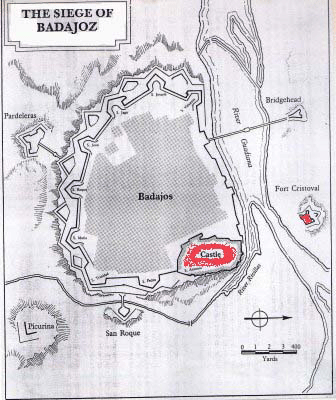 those he did have inexperienced and supported by only twenty five rank and file from that department the outlook did not bode well.. Colonel Fletcher, Wellington’s chief technical advisor and the creator of the Lines of Torres Vedras, decided to follow almost exactly the plans of the first disastrous siege. He advised Wellington to attack the strongest points of the fortifications—San Cristobal on a rocky hill on one side of the Guadiana River and the Castle on a steep sloop on the other side. Those areas colored in pink on the diagram.
those he did have inexperienced and supported by only twenty five rank and file from that department the outlook did not bode well.. Colonel Fletcher, Wellington’s chief technical advisor and the creator of the Lines of Torres Vedras, decided to follow almost exactly the plans of the first disastrous siege. He advised Wellington to attack the strongest points of the fortifications—San Cristobal on a rocky hill on one side of the Guadiana River and the Castle on a steep sloop on the other side. Those areas colored in pink on the diagram.
The problem with this was that the geological formations upon which both were built made it nearly impossible to create a breach. The stone before San Cristobal prevented any trenches being dug to its walls thus exposing any attackers over a wide stretch of terrain. In both cases a shortage of soil made it difficult to position the gun batteries.
On the 29th the British started trenches on the south side but only to draw attention away from the real point of attack. The approaches to the Castle went well but those to Cristobal went badly due to the open fire under which the British were forced to work and the stone. Conditions continued badly but by June 2nd two small batteries with a third behind them were in place. June 3rd they began firing on the fort. There was little result. On June 4th only thirteen guns of the original twenty put into place were still operational. On June 5th the action continued but with failure to breech the Castle. Cristobal went better—they had the beginnings of a breach. Bombardment continued on the 6th when it was judged Cristobal was ready for attack. By French accounts a successful attack could have been accomplished as darkness fell but the Forlorn Hope (given its name because the first usually died) was not ordered out until after midnight. They were only a party of one hundred eighty and were easily repulsed.
Firing on both continued on the 8th and 9th. With no success against the Castle the engineers finally admitted it would prove impossible to breach. The progress on Cristobal was not satisfactory but they decided to attack again. This was made earlier than the previous attempt but not before the French had time to prepare. Four hundred men were sent out and were driven back with a loss of one in three.
On June 10th, with news from Hill that Marmount and his 9th Corps was about to join Soult’s forces and outnumbered him, Wellington decided to end the siege. He pulled back the guns to Elvas in Portugal and decided to defend the border rather than be trapped in the trenches around Badajoz. Wellington remained before Badajoz until June 17th when the French joined up. He took up a new position on the Caya River deveding a line from Elvas to Camp Mayor. JV
May 2011
Battle of Fuentes de Oñoro May 5, 1811
In April Wellington had driven one of Napoleon’s oldest most decorated marshals, André Massena, Prince of Essling and Duke of Rivoli, back into Spain. But the British general still faced problems. The French held the fortress of Almeida on the Portuguese/Spanish border as well as Cuidad Rodrigo and Badajoz. He was not prepared to move further into Spain until these fortresses were in his hands. His first objective was to prevent the relief troops and supplies from reaching Almeida. He chose a ridge rising behind the village of Fuentes de Oñoro to stop Massena. There was one weakness to the position – a plateau to the east of Wellington’s line that left open the possibility of a flanking move by Massena’s cavalry which vastly outnumbered the British’s.
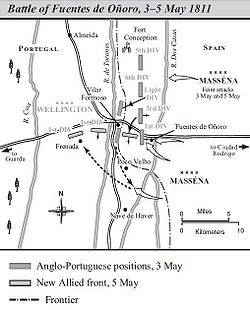
On the 3rd of May the French attacked Fuentes de Oñoro and after heavy action were repulsed. There was no fighting on the 4th. On the 5th the 7th Division were driven from Poco Velho and the arrival of the Light Division momentarily restored the fight. But then French cavalry returned to the fray and overtook the horse artillery. Napier wrote of one of the most perilous moments in the Peninsular War: “The French therefore drove in all the cavalry outguards at the first shock, cut off Ramsay’s battery of horse artillery and came sweeping in upon the reserves of cavalry and upon the seventh division. Their leading squadrons . . . were partially checked by fire but a great commotion was observed in their main body; men and horses were seen to close with confusion and tumult; men and horses were seen to close with confusion and tumult towards one point where a thick dust and loud cries, and the sparkling bladed and flashing pistols indicated some extraordinary occurrence. Suddenly the multitude became violently agitated, an English shout pealed high and clear, the mass was rent asunder, and Norman Ramsey burst forth sword in hand at the head of his battery; his horses, breathing fire, stretched like greyhounds along the plain, the guns bounded behind them like things of no weight, and the mounted gunners followed close, with heads bent low and pointed weapons in desperate career. Captain Botherton of the 14th dragoons seeing this, instantly rode forth and with his squadron shocked the head of the pursing troops and General Charles Stewart joining in the charge, took the French Colonel Lamotte fighting hand to hand; but then the main body of the French came on strongly and the British cavalry retired behind the light division which was immediately thrown into squares. The 7th division which was more advanced did the same but the horsemen were upon them first and some were cut down. The mass however stood firm and the Chasseurs Britanniques poured such a fire that their foes recoiled and seemed bewildered. . . . Many times Montbrun feigned to charge Crauford’s squares but always he found them too dangerous to meddle with and this crisis passed without a disaster, yet there was not during the whole ware a more perilous hour.” This was but one part of the battle.
The battle lasted to evening when the French began to retreat. On source says the British had 37,000 British, Portuguese and Spanish (1,500 being cavalry) with 48 guns against 48,000 French (4,500 being cavalry) and 46 guns. Estimates of French casualties range from 2200 to over 3500 and the British to under 1500. Wellington did not really account this a victory though he claimed it so to the usually recalcitrant British government because Massena was in full retreat and Almeida had not been relieved. But he had endangered his army. Jan Read in War in the Peninsula writes that Wellington later told his brother, “If Bony had been here, we should have been beat.”
Wellington had further disappointment. The French forces blew up the Almeida fortress and escaped with infuriated him. Read further quotes him, “ I begin to be of the opinion that there is nothing so stupid as a “gallant officer.” They had 13000 men to watch 1400 and on the night of the 10th to the infinite surprise of the enemy they allowed the garrison to slip through their fingers and escape. . . . There they were sleeping in their spurs even, but the French got off.” But better was to come. JV
April 2011
Massena's Retreat Continued April 10, 1811
This month we continue our cursory exploration of the Peninsular War in 1811. To recap a bit Massena. Napoleon’s Marshall sent to retake Portugal, was halted before the Lines of Torres Vedras in October of 1810. In November, unable to break through the lines, he drew back to Santarem. Life was difficult there for the French due to Wellington’s scorched earth policy when ordering the Portuguese to leave their homes and come into the Lines. By March Massena was in full retreat toward the Mondego River. This diagram is from the action at Pombal from History of the War in the Penisula by Major General Sir Wm Napier but gives a general idea of the area. 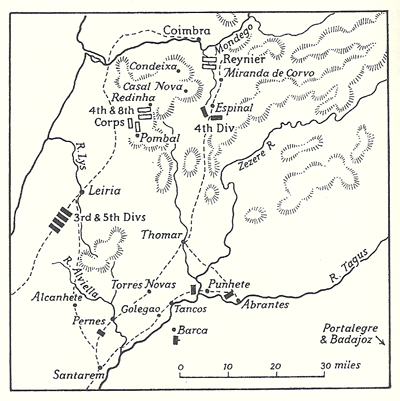
Massena’s retreat has been called one of the most harrowing of the entire war due to actions at Pombal, Redinha, Condeixa, Caza Nova, Foz d’Arouce, and Sabugal but also because of the turmoil in the British government at this time and great lack of support for the war due to the disastrous Walachern Expedition (a tale for another time). Wellington not only battled the French but also his government for troops, supplies, everything.
The French retreat as well as most of their time in Portugal and Spain was marked by inhuman atrocities. The Portuguese and Spanish answered their acts in kind. The British found burned and burning villages, rank destruction, those starving and dead from starvation, tortured peasants, and hamstrung animals left to starve. In Voices from the Peninsula Edward Costello of the 95th or Light Division, wrote home –“We closed after them, village after village giving flaming proofs of their continued atrocities. Passing through one which had been fired by reason, as we were informed, of its having been the quarters of Marshal Ney and staff an appalling instance of vengeance here occurred. The parents of one of our Cacadores had lived in this village and immediately we entered, he rushed to the house where they resided. On reaching the doorway the soldier hesitated a few seconds, but the door was open and stretched across the threshold he beheld the mangled bodies of his father and other, the blood still warm and reeking through the bayonet stabs, while an only sister lay breathing her last, and exhibiting dreadful proofs of brutality with which she had been violated.”
 Goya did a series of sketches between 1810 and 1820 called The Atrocities of War which showed the worst of both sides. A Heroic Feat: With Dead Men represents how horribly low both sides sank in wreaking retribution.
Goya did a series of sketches between 1810 and 1820 called The Atrocities of War which showed the worst of both sides. A Heroic Feat: With Dead Men represents how horribly low both sides sank in wreaking retribution.
On April 3rd The French were in Sabugal closely followed by the British. Heavy rain and dense fog spoiled the day for Wellington as conditions made it impossible to control the battle. The battle there is best 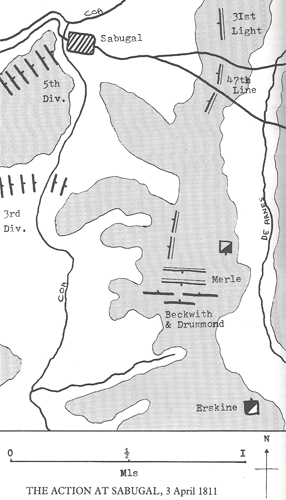 remembered for the heroic action of one brigade of the Light Division under Beckworth. For a time they battled the whole of the French army until Drummond arrived. At about that time the fog lifted and Reyneir saw he was faced with the whole of the Anglo-Portuguese army and fell into full retreat.
Some say the Battle of Sabugal was the culmination of Wellington’s struggle to free Portugal of the French. This was the third and last time he forced them in Spain when on April 10th he was to say “The Portuguese are informed that the cruel enemy . . . have been obliged to evacuate after suffering great losses, and have retired across the Aueda. The inhabitants of the country are therefore at liberty to return to their homes.“ Problems still existed—the French were in Almeida with Massena once again leading an organized army heading to Almeida with a large force.
remembered for the heroic action of one brigade of the Light Division under Beckworth. For a time they battled the whole of the French army until Drummond arrived. At about that time the fog lifted and Reyneir saw he was faced with the whole of the Anglo-Portuguese army and fell into full retreat.
Some say the Battle of Sabugal was the culmination of Wellington’s struggle to free Portugal of the French. This was the third and last time he forced them in Spain when on April 10th he was to say “The Portuguese are informed that the cruel enemy . . . have been obliged to evacuate after suffering great losses, and have retired across the Aueda. The inhabitants of the country are therefore at liberty to return to their homes.“ Problems still existed—the French were in Almeida with Massena once again leading an organized army heading to Almeida with a large force.
Massena had entered Portugal with sixty-five thousand men and had received reinforcements of ten thousand. Some say he passed into Spain with forty-five thousand, others with fifty-five thousand. Either way he suffered tremendous losses and mostly to sickness. Napoleon did not suffer failure and Marmont was sent to relieve Massena. But there was to be a final battle with the old marshall in May. JV>
March 2011
The Fall of Badajoz March 10, 1811 Napoleon insisted on keeping the reins of power over the French army in Spain and Portugal in his own hands. He had given separate powers to his various military commanders known as Marshals there which tended to put them at each other’s throat rather than in a cooperative frame of mind. The lack of a central commander-in-chief and the amount of time (sometimes months) that it took dispatches to travel back and forth proved a mortal weakness.
By March of 1811 Marshall Masenna, the 1st Duc de Rivoli and 1st Prince d'Essling, had withdrawn from before the Lines of Torres Vedras in Portugal and was in full retreat. Soult, the Duke of Dalmatia, who was in command of the forces in Andalusia was under orders to send only a small force to aid Massena. It is argued that if he had taken his entire force of 40-50,000 and pushed Wellington and his forces into the sea Napoleon would have won the war. Instead he sent the smallest force he could and in January marched instead to besiege the fortress at Badajoz. This was a gateway into Portugal or Spain depending on the direction and had to be held for any army to claim control. On January 11th he halted before the city of Olivenza. In short order the town surrendered but this presented Soult with a new problem. He had to send an escort with the prisoners and provide a garrison to hold Olivenza which left him with just over 5000 soldiers.
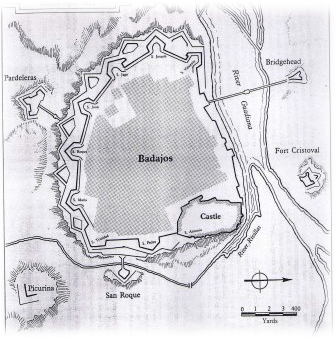
On January 26th Soult advanced on Badajoz. It was built on an incline sloping down from the castle with sharp slopes on the northeast end. The eight bastians which formed the area most easily attacked have a distance of 30 feet from ditch to rampart. Open trenches and the first parallel were in place by the beginning of February. On the third 6000 reinforcements arrived. The attack began in earnest at by the third the French began setting mines. Their progress was halted for a day by a sortie but during it Governor Menacho in charge of the castle was killed while watching from the ramparts. He was replaced by the senior brigadier Jose Imaz who had no faith in the ability of the garrison to repel the French.
By March 6th the Fr4ench were in the demi-lune of the San Juan bastion and began setting up 24 pound cannons to start blasting at the wall. By the eighth the French were firing canon just sixty feet from the wall. The Spanish cannon were silent but gunfire from flanking bastions would still be deadly for storming columns. By March 10th Soult was desperate to end the siege because of troubling dispatches he had continued to receive from his forces in Andalucia. He ordered several hours of battering canon fire in the morning with orders for storming later that afternoon.
Meanwhile he sent a summons for Imaz to surrender telling him the most honorable terms would be given. This should have alerted Imaz to the fact that Soult was not certain he could take the castle but the man called for a council of his fellow defenders who voted 13 -4 to surrender. Even though Imaz knew (through semaphore signals) that Wellington was sending two divisions to aid him, he based his surrender on the purported fact that no relief was possible. AT 3 in the afternoon he surrendered and the French occupied the castle. The next day the Spanairds marched out—there were almost 8000 men. The French found enough food to feed that number for over a month along with plenty of guns and ammunition. Sir Charles Oman in his History of the Peninsular War states that there can be no doubt that had Governor Menacho not been killed the French would never have taken Badajoz.
This very brief account of the taking of Badajoz leaves out many details not only of the attack but of conditions and happenings in Spain and Portugal. JV
February 2011
February and our thoughts turn to love. But this time let’s consider love between members of political parties in regency times. First a bit of background.
George III took a turn into madness again in October 1810. While it was thought the king would recover, it was believed it would take more time than the government had to let matters lie fallow. The laws etc which governed England’s struggle with Napoleon, financing the war and keeping the country’s economy afloat could not be delayed without dire results. Spencer Perceval wrote to George Augustus Frederick, Prince of Wales, who like our present day Prince Charles had been a king-to-be for a long time, that the government would introduce a Regency Bill placing him in power but with restrictions similar to the one in 1789. There was much dithering back and forth about the restrictions and other matters mainly because those in power who were Tories believed the Prince would upon assuming control, form a new government made up of the opposition party, the Whigs. Think Tory-Conservative vs Whig-Liberal. And therein lays our “love” story.
 You see like any young man, George, Prince of Wales or Prinny as some called him, rebelled against his father’s control. He early on launched himself into a misspent youth that perhaps never did end. Since his father was Tory through and through he chose Whigs for friends. Especially Whigs who caused his father pain like Charles Fox. Though well into middle-age (being 48 in 1810) Prinny had never distanced himself from the Whigs although he secretly no longer believed in many of their causes like Catholic Emancipation. Both parties fully expected him to honor long years of friendship and support by forming a Whig government. This was why limitations on the regency were proposed.
You see like any young man, George, Prince of Wales or Prinny as some called him, rebelled against his father’s control. He early on launched himself into a misspent youth that perhaps never did end. Since his father was Tory through and through he chose Whigs for friends. Especially Whigs who caused his father pain like Charles Fox. Though well into middle-age (being 48 in 1810) Prinny had never distanced himself from the Whigs although he secretly no longer believed in many of their causes like Catholic Emancipation. Both parties fully expected him to honor long years of friendship and support by forming a Whig government. This was why limitations on the regency were proposed.
But Prinny had developed a sense of survival if nothing else. He knew he daren’t throw out the present government if his father would recover soon. Prinny had also been warned by George III’s doctors that a change in government could lead to an exacerbation of the king’s symptoms and cause a setback and even perhaps a fatal attack. With this in mind he made a counteroffer to the limitations stating that he would not form a Whig government if limitations were not put in place. On February 5, 1811, two hundred years ago this month the Regency Bill became law and George Augustus Frederick, Prince of Wales, was made Regent.
On the next day the Privy Counsellors went to Carlton House (Prinny’s London residence) to swear in the Prince as Regent. Outside the house the Grenadier Guards band played “God Save the King.” After they had waited an hour and a half Prinny appeared, swore the oaths of office and signed the necessary documents. The Whigs believed now their hour had come. Their years of courting the Prince would yield ten fold. Unfortunately they were in for a break up rather than a consummation. More on that in later months.
January proved a profitable book search month. We pre-ordered THE VERY THING The Memoirs of Drummer Bentinck, Royal Welch Fusiliers, 1807-1823 ; BATTLE OF OCANA, THE: The Army of Spain's Greatest Victory over the French; EYEWITNESS TO THE PENINSULAR WAR AND THE BATTLE OF WATERLOO: The Letters and Journals of Lieutenant Colonel James Stanhope 1803 to 1825. I also purchased Highland Dress; Chronicles of Bow Street Police-Office: With an Account of the Magistrates, Runners, and Police; and Wars Against Napoleon, the: Debunking the Myth of the Napoleonic Wars a book that looks especially interesting with a very different point of view on Napoleon.
January 2011
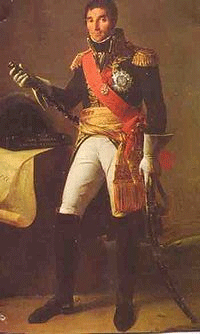
January 1811. During the autumn of 1810 Arthur Wellesley, then Baron Douro and Viscount Wellington (both titles dating from 1809), the future Duke of Wellington had hunkered down behind the Lines of Torres Vedras before Lisbon, Portugal and waited. He didn’t know it but he had reached the midpoint of the Peninsular War.
Wellington had insisted on a scorched earth policy as he brought his troops and Portuguese peasants behind the Lines. This series of defenses, constructed over the span of a year on Wellington’s far-sighted orders, were nigh impregnable. In November he had watched the French general André Masséna, 1st Duc de Rivoli, 1st Prince d’Essling (in a portrait to the left at age 58) forced to turn from the Lines. Masséna ordered his starving sickly army back and situated his three corps in a twenty mile area. There he waited (and probably prayed) for Wellington to attack. But the English general had weighed the pros and cons and decided it lay in the British army’s best interest to wait until starvation forced the French into an active retreat. He had thought this would happen by December but it was actually February before Masséna grew desperate and ended the stalemate.
Three long years since the start of the Peninsular War with General Arthur Wellesley’s (the future Wellington) 1808 victory at Viemero in Portugal and General Sir John Moore’s march into Spain and wild retreat to Corunna the tide had begun to turn in favor of the English. There were still defeats in 1811 but there was more hope than ever for future victory.
The 200th anniversary of many events in the long war against Napoleon is sparking the reprinting of old resources and the writing of new. I have pre-ordered three promising texts: EYEWITNESS TO THE PENINSULAR WAR AND THE BATTLE OF WATERLOO: The Letters and Journals of Lieutenant Colonel James Stanhope 1803 to 1825 Recording His Service by Gareth Glover; BATTLE OF OCANA, THE: The Army of Spain's Greatest Victory by Pierre Juhel; and THE VERY THING: The Memoirs of Drummer Bentinck, Royal Welch Fusiliers, 1807-1823 by Jonathan Crook.
Happy New Year! May you prosper in health and fortune. JV
